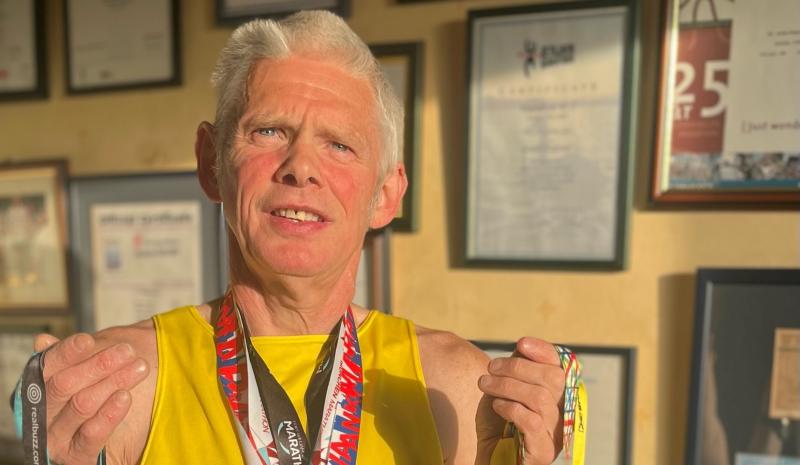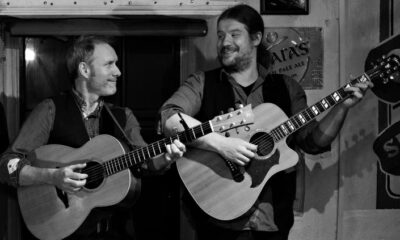News
Photo project to help the young understand Alzheimers

With over 4,000 people over the age of 65 years suffering from Alzheimers Disease in counties Galway, Mayo and Roscommon, the chances are we will all have a close encounter with the condition at some stage in our lives.
A unique project which aims to create a deeper understanding of the degenerative brain disease among young people as well as giving them an entirely useful life skill has also had the triple affect of raising a great deal of money for a group which provides vital services to those afflicted by Alzheimers as well as their families.
It was the photographer Alan Guiomard of Yann Studios Photography on Prospect Hill who first had the idea of teaching students the intricacies of photography, often lost in an age of digital phones.
“We were just talking about it in the office last year. Everything nowadays is digitized. Digital photography means the camera thinks for you, it’s so automated. I thought wouldn’t it be good to teach people the basic skills we learned,” he reflected this week.
“Years ago, we used films of 12 or 24. Nowadays you might take 400 pictures for a single shot without thinking. I wanted to teach students to actually stop and think.”
Having encountered John Grant of Western Alzheimers, he was impressed by the passion the Ballindine man exuded when talking about the disease and its devastating impact on loved ones.
As well as providing in-home support services to families in Galway, Mayo and Roscommon, Western Alzheimers runs a respite centre in Ballindine, which is about to be extended due to demand, and a respite centre in Athenry, which provides respite, day care and long stay services. It is currently in advanced talks with the Health Services Executive (HSE) to set up a centre on a site at Merlin Park Hospital.
Alan decided to set up a workshop for Transition Year Students teaching them photography skills such as correct lighting, composition, rule of thirds where the subject is placed off centre. John Grant would give them a talk about Alzheimers. Students could then work together in teams to produce a photograph inspired by their understanding of Alzheimers.
The photos would be posted on a Facebook page with the top 24 picked based on the amount of ‘likes’ they attracted. The students behind the 24 pictures were invited to a night in the Menlo Park Hotel where they were asked to give a presentation on what their photograph meant and how they came to realise it. The final 12 were then selected for inclusion in the calendar, which would be sold to raise money for Western Alzheimers.
The results were nothing short of astonishing, admits Alan. The creativity which was displayed in the 58 photographs from the 13 schools simply involved blew him away.
“Some of them were quite abstract – you had an entry from St Raphael’s College in Loughrea called Love is a many petalled thing, with six daisies in a circle with a seventh in the centre with half the petals gone to represent memory loss,” recalls Alan.
“An entry from Gort Community School had a head drawn in the sand, with half of it washed away. They had to wait hours for the tide to come in.
“The Bish had a photo called My Favourite Stranger, with a woman sitting beside her brother, but her brother is only half there. It shows that she knows him on a good day but on a bad day he’s a stranger.”
Over €10,000 was raised through the sales of the calendar. The project proved so successful, they decided to launch it again this year. So far 17 schools are on board.
Alan gives his time for free. This year’s calendar will put on sale in mid-November. The money raised goes towards running the respite centres and providing services for families at home.
Connacht Tribune
West has lower cancer survival rates than rest

Significant state investment is required to address ‘shocking’ inequalities that leave cancer patients in the West at greater risk of succumbing to the disease.
A meeting of Regional Health Forum West heard that survival rates for breast, lung and colorectal cancers than the national average, and with the most deprived quintile of the population, the West’s residents faced poorer outcomes from a cancer diagnosis.
For breast cancer patients, the five-year survival rate was 80% in the West versus 85% nationally; for lung cancer patients it was 16.7% in the west against a 19.5% national survival rate; and in the West’s colorectal cancer patients, there was a 62.6% survival rate where the national average was 63.1%.
These startling statistics were provided in answer to a question from Ballinasloe-based Cllr Evelyn Parsons (Ind) who said it was yet another reminder that cancer treatment infrastructure in the West was in dire need of improvement.
“The situation is pretty stark. In the Western Regional Health Forum area, we have the highest incidence of deprivation and the highest health inequalities because of that – we have the highest incidences of cancer nationally because of that,” said Cllr Parsons, who is also a general practitioner.
In details provided by CEO of Saolta Health Care Group, which operates Galway’s hospitals, it was stated that a number of factors were impacting on patient outcomes.
Get the full story in this week’s Connacht Tribune, on sale in shops now, or you can download the digital edition from www.connachttribune.ie. You can also download our Connacht Tribune App from Apple’s App Store or get the Android Version from Google Play.
Connacht Tribune
Marathon Man plans to call a halt – but not before he hits 160 races

On the eve of completing his 150th marathon, an odyssey that has taken him across 53 countries, Loughrea’s Marathon Man has announced that he is planning to hang up his running shoes.
But not before Jarlath Fitzgerald completes another ten races, making it 160 marathons on the occasion of his 60th birthday.
“I want to draw the line in 2026. I turn 57 in October and when I reach 60 it’s the finishing line. The longer races are taking it out of me. I did 20 miles there two weeks ago and didn’t feel good. It’s getting harder,” he reveals.
“I’ve arthritis in both hips and there’s wear and tear in the knees.”
We speak as he is about to head out for a run before his shift in Supervalu Loughrea. Despite his physical complaints, he still clocks up 30 miles every second week and generally runs four days a week.
Jarlath receives injections to his left hip to keep the pain at bay while running on the road.
To give his joints a break, during the winter he runs cross country and often does a five-mile trek around Kylebrack Wood.
He is planning on running his 150th marathon in Cork on June 4, where a group of 20 made up of work colleagues, friends and running mates from Loughrea Athletics Club will join him.
Some are doing the 10k, others are doing the half marathon, but all will be there on the finishing line to cheer him on in the phenomenal achievement.
Get the full story in this week’s Connacht Tribune, on sale in shops now, or you can download the digital edition from www.connachttribune.ie. You can also download our Connacht Tribune App from Apple’s App Store or get the Android Version from Google Play.
CITY TRIBUNE
Galway ‘masterplan’ needed to tackle housing and transport crises

From the Galway City Tribune – An impassioned plea for a ‘masterplan’ that would guide Galway City into the future has been made in the Dáil. Galway West TD Catherine Connolly stated this week that there needed to be an all-inclusive approach with “vision and leadership” in order to build a sustainable city.
Deputy Connolly spoke at length at the crisis surrounding traffic and housing in Galway city and said that not all of the blame could be laid at the door of the local authority.
She said that her preference would be the provision of light rail as the main form of public transport, but that this would have to be driven by the government.
“I sat on the local council for 17 years and despaired at all of the solutions going down one road, metaphorically and literally. In 2005 we put Park & Ride into the development plan, but that has not been rolled out. A 2016 transport strategy was outdated at the time and still has not been updated.
“Due to the housing crisis in the city, a task force was set up in 2019. Not a single report or analysis has been published on the cause of the crisis,” added Deputy Connolly.
She then referred to a report from the Land Development Agency (LDA) that identified lands suitable for the provision of housing. But she said that two-thirds of these had significant problems and a large portion was in Merlin Park University Hospital which, she said, would never have housing built on it.
In response, Minister Simon Harris spoke of the continuing job investment in the city and also in higher education, which is his portfolio.
But turning his attention to traffic congestion, he accepted that there were “real issues” when it came to transport, mobility and accessibility around Galway.
“We share the view that we need a Park & Ride facility and I understand there are also Bus Connects plans.
“I also suggest that the City Council reflect on her comments. I am proud to be in a Government that is providing unparalleled levels of investment to local authorities and unparalleled opportunities for local authorities to draw down,” he said.
Then Minister Harris referred to the controversial Galway City Outer Ring Road which he said was “struck down by An Bord Pleanála”, despite a lot of energy having been put into that project.
However, Deputy Connolly picked up on this and pointed out that An Bord Pleanála did not say ‘No’ to the ring road.
“The High Court said ‘No’ to the ring road because An Bord Pleanála acknowledged it failed utterly to consider climate change and our climate change obligations.
“That tells us something about An Bord Pleanála and the management that submitted such a plan.”
In the end, Minister Harris agreed that there needed to be a masterplan for Galway City.
“I suggest it is for the local authority to come up with a vision and then work with the Government to try to fund and implement that.”















